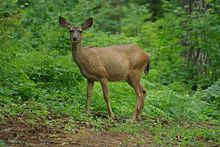- Closed-cone pine forest
-
Closed-cone pine forest is a plant community of coastal California and several offshore islands. It consists of stands of Bishop Pines, Monterey Pines, and others which rely on fire or strong heat to open their cones and release the seeds.
Contents
Closed-cone Pines
The most widespread naturally of the closed-cone pines is Bishop Pine (Pinus muricata), which can be found along the coast from Humboldt County, California in the north to the northwestern corner of Baja California in the south. Knobcone Pine (Pinus attenuata) forests can occur further inland, on dry, rocky soils. Monterey Pine (Pinus radiata) was once limited to the Monterey Peninsula, two other sites in central California, and Guadalupe and Cedros Islands off the coast of Baja California, but has now been introduced elsewhere in California and around the world. Most of these trees have an average life-span of around 50-90 years [1]
Climate
The weather of these forests is quite mild in both winter and summer. Temperatures rarely go below freezing or grow uncomfortably warm. Closed-cone pine forests of Californian are located in cool-summer Mediterranean climate regions along the coast with cool wet winters and foggy, dry summers. Despite the fact that the summers are dry, the air is consistently humid due to frequent coastal fog brought in by interior heat. The fog also supplies irrigation when it passes through the conifer needles of the pines. The moisture is caught this way and drips to the forest floor. Thus, drought is avoided by up to 40%[2]. In the autumn fog is less frequent and it is during this season when occasional heat waves are possible. This is when fires are most likely. Precipitation ranges from 20 to 60 inches a year, depending on the locale.
Other Flora and Fauna
While the pines are, by far, the most common tree in these forests, Coast live oaks often accompany them. Due to the relatively short lifespan of closed-cone pines, many dead trunks and snags are available and attract a whole host of wildlife ranging from woodpeckers, titmice, chickadees, warblers, squirrels, chipmunks, raccoons, mountain lions, deer and many others. The lush undergrowths, typical of the forests, are excellent habitat as well. Blackberries, wild roses, wood mints, California honeysuckle, currants, and others are common. The flora and fauna varies from area to areas, especially the southern and northern closed-cone pine regions.
External Links
References
See also
- Fire ecology
- Conifer forest
- California montane chaparral and woodlands- (subecoregion')
- California interior chaparral and woodlands- (subecoregion)
Categories:- Plant communities of California
- Flora of the Channel Islands of California
- Flora of Baja California
- Forests of Mexico
- Forests of California
- Plant communities of the West Coast of the United States
- California stubs
Wikimedia Foundation. 2010.


